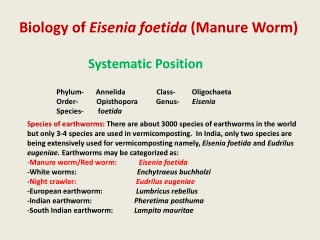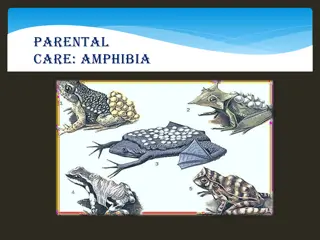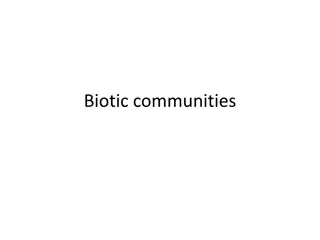Biology of Eisenia foetida (Manure Worm)
Learn about Eisenia foetida, a key earthworm species used in vermicomposting, its identification, ecology, efficiency, and morphology. Discover its burrowing habits, feeding behavior, reproduction capabilities, and environmental preferences for optimal performance in composting.
0 views • 25 slides
Amphibian Parental Care and Protection Methods
Parental care in amphibians involves various strategies such as nest building, direct carrying of eggs, and protecting developing eggs in different ways like laying eggs on leaves, burrowing, or creating foam nests. These methods ensure the survival of amphibian species by providing a safe environme
0 views • 11 slides
Understanding Fossorial Adaptation in Animals
Animals adapt to subterranean environments through anatomical and physiological modifications in a process known as fossorial adaptation. This adaptation involves creating subterranean zones through digging, leading to changes influenced by both the environment and the animals themselves. Fossorial
0 views • 17 slides
Fossorial Specimens: Mole and Caecilian Adaptations
Fossorial specimens, including the mole and caecilian, are uniquely adapted for subterranean burrowing. The mole, commonly known for its wedge-shaped head and reduced eyes, lives in tunnels and feeds on small worms and insects. On the other hand, the limbless caecilian, resembling a worm, thrives in
1 views • 25 slides
Fascinating World of Earthworms: An In-Depth Look
Earthworms, belonging to the phylum Annelida, are nocturnal creatures found in moist soil. They play a crucial role in soil health and decomposition processes. With their unique morphology and habitat preferences, earthworms exhibit interesting behaviors like burrowing and regenerating. This article
0 views • 19 slides
Understanding Biotic Communities and Benthic Ecosystems
Living organisms in an area form biotic communities categorized into producers, consumers, omnivores, detrivores, and decomposers. Aquatic organisms such as plankton, benthos, and nekton play vital roles. Benthic communities refer to organisms attached to or burrowing in aquatic ecosystems, influenc
0 views • 17 slides





